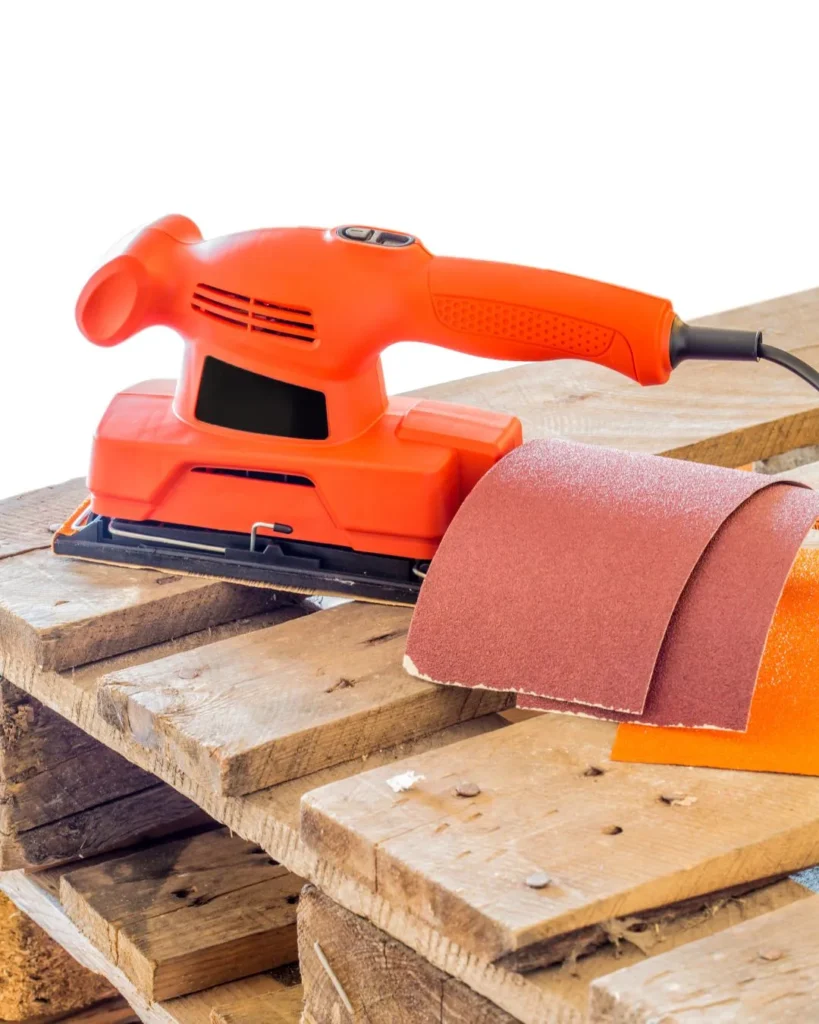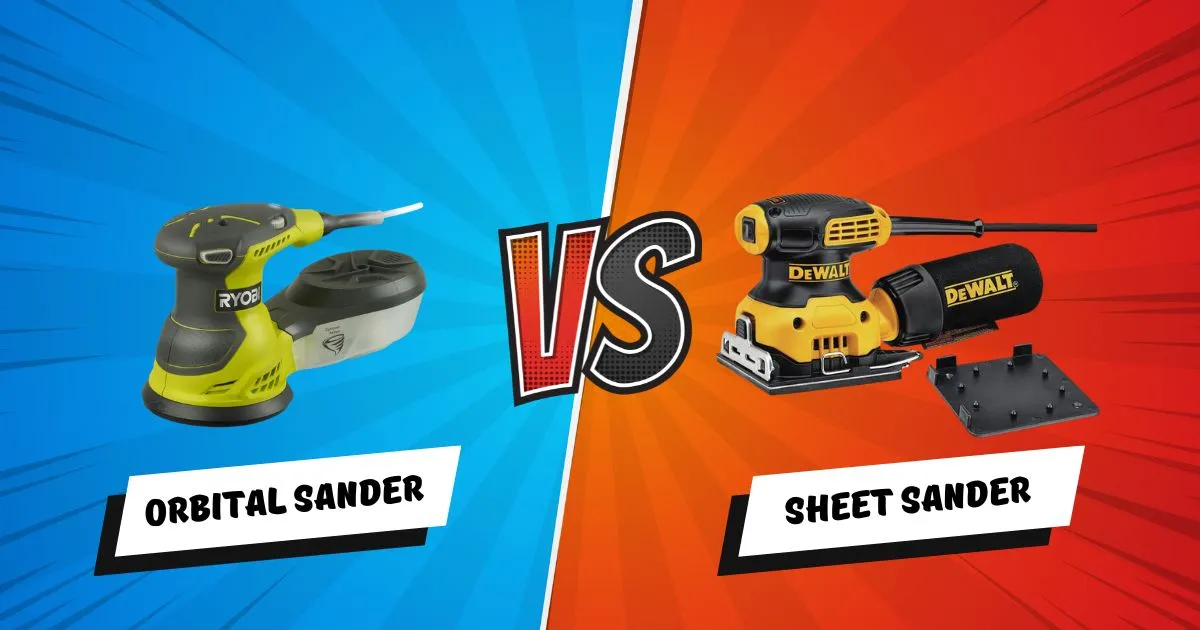Orbital vs Sheet Sander: Quick Comparison for DIYers
If you love DIY projects, you know sanding is key for a smooth finish. The right sander can greatly improve your work’s quality and speed. You might wonder between orbital sanders and sheet sanders for your tasks. But when it comes to Orbital vs Sheet Sander, which one truly stands out? The answer might surprise you!
It’s important to know the differences between these sanders. Orbital sanders are perfect for fine details and smooth finishes. On the other hand, sheet sanders are best for big, flat areas. Knowing what each sander does best can help you choose the right one for your project.
Table of Contents
Key Takeaways
- Orbital sanders are ideal for detail work and smooth finishes.
- Sheet sanders are better suited for large, flat surfaces.
- Choosing the right sander improves project quality and efficiency.
- Understanding the task at hand helps in selecting the appropriate sander.
- Both types of sanders have their unique advantages.
Understanding the Basics of Sanders
The world of sanding tools can seem overwhelming. But, starting with the basics can greatly improve your projects. Sanders are key for smoothing surfaces, getting them ready for finishing, and removing old finishes.
What Is an Orbital Sander?
An orbital sander moves in a circular motion. It’s perfect for smoothing surfaces without leaving marks. It’s versatile and works well on wood and metal.
What Is a Sheet Sander?
A sheet sander uses a rectangular sanding pad. It’s simple and effective for sanding flat surfaces. DIYers find it great for projects needing precision.
Key Differences at a Glance
| Feature | Orbital Sander | Sheet Sander |
|---|---|---|
| Motion | Circular | Linear |
| Sanding Pad | Round | Rectangular |
| Ideal Use | Smoothing surfaces, removing old finishes | Sanding flat surfaces, precision work |
Orbital vs Sheet Sander
Choosing between orbital and sheet sanders depends on their unique features. Orbital sanders have a circular motion, are powerful, and are easy on the hand. Sheet sanders move back and forth, are good for flat surfaces, but might need more care to avoid uneven sanding.
Motion Patterns and How They Affect Results
The way a sander moves changes how it sands. An orbital sander uses a circular motion. This helps avoid sanding marks and is perfect for smooth finishes. On the other hand, a sheet sander moves side to side. It works well on flat surfaces but needs careful use to prevent uneven sanding.
Power and Speed Capabilities
Power and speed are key for a sander’s performance. Orbital sanders, like those from Festool, have adjustable speeds. This lets you control how aggressive the sanding is, based on the material. Sheet sanders have a steady speed, which is usually enough for their tasks.
Handling and Ergonomics
Ergonomics matter a lot for comfort and avoiding fatigue during long sanding sessions. Orbital sanders are designed to fit well in your hand, making them comfortable to use. Sheet sanders, with their back-and-forth motion, can be harder to handle because of the need for steady pressure.
| Feature | Orbital Sander | Sheet Sander |
|---|---|---|
| Motion Pattern | Circular | Linear |
| Speed Variability | Often Variable | Typically Fixed |
| Ergonomics | Highly Ergonomic | Less Ergonomic |
Performance Comparison for Different Materials
Orbital and sheet sanders have their own strengths and weaknesses. They work differently on various materials, from hardwoods to softwoods. Knowing these differences is key to getting the finish you want.
Finish Quality on Hardwoods
Orbital sanders are top picks for hardwoods because they give a smooth finish. They work best with fine-grit sanding pads for a high-quality look. For example, a Ryobi orbital sander with the right grit can give a pro-grade finish.
“Orbital sanders are great for hardwoods because they don’t leave swirl marks like other sanders can,” notes a seasoned woodworker. This makes them perfect for projects where looks matter a lot.
Working with Softwoods and Plywood
Sheet sanders are better for softwoods and plywood, especially with the right ryobi sanding sheets. They are more aggressive, which means they can remove material fast. But, they might not give as smooth a finish as an orbital sander.

Handling Paint and Varnish Removal
Orbital sanders with the right attachment are great for removing paint and varnish. They balance material removal with finish quality well. This makes them a versatile choice for these tasks.
Dust Collection Efficiency
Dust collection is crucial when sanding. Some orbital sanders have dust collection systems that beat many sheet sanders. This feature improves visibility and cuts down on cleanup time. When picking a sander, look for one with good dust collection for a better sanding experience.
In conclusion, picking between an orbital sander and a sheet sander depends on your project’s needs. Consider the material and finish you want. Choosing the right tool ensures professional-quality results.
Project-Specific Applications for DIYers
Knowing when to use orbital and sheet sanders is key for top-notch DIY work. The right sander depends on your project’s needs.
Furniture Refinishing Projects
An orbital sander is best for furniture makeovers. It smooths out tricky shapes and curves. This makes it perfect for detailed furniture.
Orbital vs Sheet Sander for Woodworking
In woodworking, both sanders have their uses. Orbital sanders are great for fine details and odd shapes. Sheet sanders work best on big, flat areas. They’re ideal for sanding down large surfaces.
Home Renovation Tasks

For big jobs like sanding floors, a sheet sander is faster. But for small, detailed work, an orbital sander is better.
Craft and Small Detail Work
For small, precise tasks, an orbital sander is best. It’s great for detailed work without harming the area around it. This is a must-have for crafters and DIY fans.
Choosing the right sander for your project ensures a great finish. Whether you’re refinishing, woodworking, or renovating, knowing the strengths of each sander helps you succeed.
Top Brands and Models to Consider
Choosing the right sander means looking at top brands and models. These are known for being durable and efficient. Orbital and sheet sanders from certain brands are especially popular for their performance and user satisfaction.
Best Orbital Sander Options for Different Budgets
There are many orbital sanders for every budget. For those on a budget, the Ryobi Orbit Sander is a great choice. It has features like variable speed and good dust collection. On the other hand, Festool Orbital Sanders are top-notch for professionals or those who want the best.
Ryobi Orbit Sander Models and Features
Ryobi has many orbit sander models that are both affordable and functional. They come with variable speed control and effective dust collection. These features make sanding easier and cleaner.
Festool Orbital Sander: Premium Performance
Festool orbital sanders are top-tier tools for sanding. They have powerful motors, ergonomic designs, and deliver excellent finishes. These are perfect for professional woodworkers and serious DIYers who need reliable results.
Quality Sheet Sanders and Ryobi Sanding Sheets

For sheet sanders, the sanding sheets are just as important. Ryobi Sanding Sheets work well with many sanders and are durable. When picking a sheet sander, look for ones that use high-quality sheets for the best results.
In summary, looking at brands like Ryobi and Festool can help you find the best sander. Whether you’re on a budget or want the best tools, there’s a sander for you.
Maintenance and Longevity Tips
Proper care and maintenance of your orbital or sheet sander can make it last longer and work better. Regular upkeep ensures it performs at its best and lasts longer.
Proper Cleaning and Storage
Always clean your sander after each use to get rid of dust and debris. Use compressed air or a soft brush to clean out vents and crevices. Keep your sander in a dry, cool spot, away from sunlight. This helps avoid damage and keeps it working well.
Replacing Pads and Parts
Check and replace worn-out pads and parts often. For orbital sanders, look for worn-out sanding pads and replace them when needed. For sheet sanders, make sure sanding sheets are aligned right and not torn. Replacing these parts keeps your sander working well and protects your work.
Extending the Life of Your Sander
To make your sander last longer, follow the maker’s maintenance and use tips. Regularly oil moving parts and watch for wear signs. Proper use and care can greatly reduce wear and tear.
Troubleshooting Common Issues
Problems with sanders include less suction power, uneven sanding, and motor failure. Regular cleaning and upkeep can stop many of these problems. Check your user manual for specific tips for your sander model.
| Maintenance Task | Frequency | Benefit |
|---|---|---|
| Clean the sander | After each use | Prevents dust buildup, maintains performance |
| Inspect and replace pads/parts | Regularly | Maintains sanding quality, prevents damage |
| Lubricate moving parts | As needed | Reduces wear and tear, extends lifespan |
Conclusion: Choosing the Right Sander for Your Needs
When picking between an orbital and a sheet sander, knowing their strengths is key. You’ve learned about their different ways of moving, power, and comfort. These factors affect how well they work on different materials and tasks.
DIYers have to think about what they need. Orbital sanders, from brands like Ryobi and Festool, are great for making furniture look new again. They’re versatile and give a smooth finish. Sheet sanders, however, are better for big, flat areas and are easier on the wallet.
Think about your projects and the materials you use to choose the right sander. Whether you’re fixing up your home or working on crafts, picking the right tool will improve your work. It will also make your projects more efficient.
FAQ
What is the main difference between an orbital sander and a sheet sander?
Orbital sanders move in circles, perfect for smooth surfaces. Sheet sanders have a rectangular pad for flat surfaces.
Which type of sander is better for fine finishes on hardwoods?
Orbital sanders are best for hardwoods. Their circular motion helps avoid marks.
Can I use a sheet sander for furniture refinishing projects?
Sheet sanders work well on flat areas for furniture. But, orbital sanders are better for curved or detailed spots.
Are Ryobi sanding sheets compatible with all sheet sanders?
Ryobi sheets fit Ryobi sanders and some others. Always check before buying.
How do I maintain my orbital or sheet sander to extend its lifespan?
Clean and store your sander right. Replace worn parts and follow the maker’s maintenance tips.
What are some top brands for orbital sanders that offer good performance and value?
Ryobi and Festool are top picks. Ryobi has affordable, efficient models. Festool offers premium quality.
Can an orbital sander be used for removing old paint or varnish?
Yes, orbital sanders work well for removing old finishes. They have strong sanding action.
What should I consider when choosing between an orbital sander and a sheet sander for woodworking projects?
Think about the task, surface, and finish you want. Orbital sanders are great for details and curves. Sheet sanders are best for large, flat areas.

